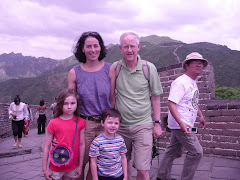
This - my third post about our weekend in the mountains - covers our visit to Nikko, the historic capital of Japan's "Shogun" period captured by James Clavell. The original shogun, Ieyasu Tokugawa (1542-1616), who is buried here, is said to have "unified" the country in 1603, when he was named "Seii-taishogun," or "great generalissimo." (All of my historical info, btw, comes from the Nikko Tourist Association's website, which also has very reliable travel info and suggestions for short or longer walks in the area.)
We arrived in Nikko on this old-style train, which has red velvet seats. Two train lines go to Nikko: the JR (Japan Rail) line and the private Tobu line, and each has its own train station a few blocks apart. Does not seem like the best use of public land...

The Tobu train station has a Vermont-ish style.

After 1.5 hrs on 2 trains from Nasu-shiobara to Nikko, I thought it would be a good idea to to walk uphill through the town to reach the major shrines, instead of taking a bus. Um, bad idea. Arno was so unhappy - and his whining made me furious! This captures the moment perfectly.

I bribed Arno to keep walking by promising a piece of chocolate at the top of the hill. On the way, we found that Nikko is packed with old-world Japanese houses and temples, including one with a Volvo parked outside and another high on a hill.


The first "must-see" sight is the red-lacquered Shinkyo (Sacred Bridge) over the Daiya River. For centuries, only the emperor could cross it; now anyone can pay about 400 yen to stand on it. The bridge and river are lovely, but a busy intersection nearby lessens the romance.

Nearby, up some mossy stone stairs, is the Rinnoji Temple complex. A huge temple - but we skipped it, on the advice of our Frommer's guidebook, to stroll in the gorgeous Syouyoen Japanese garden that was constructed centuries ago. Its Japanese maples were at peak color and the children loved skipping on stone paths and bridges. The family photo at the top of this post was taken there, and here's another shot.

Dozens of massive koi swim in the pond, and fish food is available in small bamboo containers, shown here, for 30 yen. The fish were not hungry, though.

Next up, the Toshogu Shrine, where Tokugawa-sama is buried. The structures decorated with gold leaf were impressive, but we marveled at the massive cedar trees encircling the shrine, which were actually planted here centuries ago. In this photo, see how tiny the people are compared to the huge stone torii gate at the entrance to the shrine complex - and the trees tower over that.

After you buy tickets, you walk by the "sacred stable," which allegedly houses a white horse (unseen by us). The stable's carving includes the famous "three monkeys" of "hear no evil, see no evil, speak no evil" fame. Which is a commentary on childhood innocence, blah, blah.

The monkeys:

To enter the shrine, a crowd waited to walk thru the Yomeimon gate, which has 500 sculptures...

...including samurai guards on either side.

Once inside, we looked it over and were suitably impressed - especially about the trees!

We didn't stay long because we had to catch a train to reach our hotel. We returned to the Shinkyo Bridge, ran for a bus, and reached the train station just in time. Congratulations all around after a sometimes-trying day of sightseeing and choco-bribery.
If this sounds like a good trip for you, there are several other sightseeing stops in Nikko, including Lake Chuzenji, the Kegon and Ryuzu waterfalls, and neat-looking hikes in the Senjogahara marshlands. Our kids are not old enough, or maybe willing enough, to deal w/that now. Maybe another time.

No comments:
Post a Comment